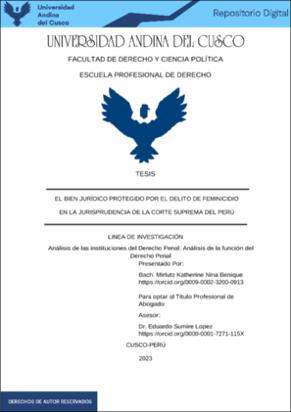| dc.contributor.advisor | Sumire Lopez, Eduardo | |
| dc.contributor.author | Nina Benique, Mirlutz Katherine | |
| dc.date.accessioned | 2023-12-18T21:53:48Z | |
| dc.date.available | 2023-12-18T21:53:48Z | |
| dc.date.issued | 2023-06-30 | |
| dc.identifier.uri | https://hdl.handle.net/20.500.12557/5963 | |
| dc.description.abstract | El presente trabajo de investigación titulado “El bien jurídico protegido por el
delito de feminicidio en la jurisprudencia de la corte suprema del Perú” se
analiza la interpretación restrictiva realizada por la Corte Suprema de Justicia del
Perú, mediante el Acuerdo Plenario Nº 001-2016/CJ-116, respecto al bien
protegido relacionado además al sujeto pasivo del delito de feminicidio, tipificado
en el artículo 108-B del Código Penal.
En efecto las Salas Supremas en materia penal consideran que la víctima del
delito de feminicidio solo puede ser la mujer entendido como identidad biológica
y por consiguiente el bien jurídico protegido es la vida de la mujer biológicamente
hablando.
La interpretación respecto al sujeto pasivo del delito de feminicidio que en
esencia nos lleva al bien jurídico protegido efectuado en el Acuerdo Plenario Nº
001-2016/CJ-116 es una interpretación restringida y vulnera el derecho a la
igualdad y la no discriminación de mujeres que como identidad de género no
acoge a las mujeres transgénero, que también son víctimas de homicidio por su
condición de mujer.
La interpretación restrictiva de los jueces supremos del artículo 108-B del código
penal no recoge la amplitud de comprensión de la identidad de género mujer que
ha asumido el Tribunal Constitucional en el caso Rodolfo Enrique Romero
Saldarria. y de la Corte Interamericana de Derechos Humanos, por ejemplo en
el caso Vicky Hernández Vs Honduras que determinó que la lucha que se ejerce
desde los tratados internacionales por suprimir la violencia de género contra la mujer implica también el asesinato a las mujeres transgénero por su identidad
de género.
Esta realidad jurisprudencial no es distinto a la concepción machista y
discriminatorio que se percibe en los actores del proceso penal, conforme se
podrá evidenciar en las exploraciones efectuadas que como datos se consigna
en la presenta investigación.
El homicidio de mujeres en un sentido amplio merece una comprensión también
amplia sobre el bien jurídico protegido en el delito de feminicidio, lo que ayudará
a una igualdad de trato y sin discriminación a todas las mujeres que se identifican
como tal y no restringida únicamente a las mujeres en sentido biológico, aspecto
que podrá incidir también en la comprensión del sujeto activo del delito,
coherente con la interpretación convencional efectuada por la Corte
Interamericana de Derechos Humanos. | es_PE |
| dc.description.abstract | The present research work entitled "The legal property protected by the crime of
femicide in the jurisprudence of the Supreme Court of Peru" analyzes the
restrictive interpretation made by the Supreme Court of Justice of Peru, through
Plenary Agreement No. 001-2016/CJ-116, regarding the protected property
related also to the passive subject of the crime of femicide, typified in Article 108-
B of the Criminal Code.
In effect, the Supreme Courts in criminal matters consider that the victim of the
crime of femicide can only be the woman understood as biological identity and
therefore the protected legal right is the life of the woman biologically speaking.
The interpretation regarding the passive subject of the crime of femicide that in
essence leads us to the protected legal good made in Plenary Agreement No.
001-2016/CJ-116 is a restricted interpretation and violates the right to equality
and non-discrimination of women that as gender identity does not welcome
transgender women, who are also victims of homicide because of their status as
women.
The restrictive interpretation of the supreme judges of article 108-B of the penal
code does not include the broad understanding of female gender identity that has
been assumed by the Constitutional Court in the Rodolfo Enrique Romero
Saldarria case and by the Inter-American Court of Human Rights, for example in
the Vicky Hernández Vs Honduras case, which determined that the struggle that
is exercised from the international treaties to suppress gender violence against
women also implies the murder of transgender women because of their gender
identity. | en_US |
| dc.format | application/pdf | es_PE |
| dc.language.iso | spa | es_PE |
| dc.publisher | Universidad Andina del Cusco | es_PE |
| dc.rights | info:eu-repo/semantics/openAccess | es_PE |
| dc.rights.uri | https://creativecommons.org/licenses/by-nc-nd/4.0/ | es_PE |
| dc.subject | Feminicidio | es_PE |
| dc.subject | Violencia de género | es_PE |
| dc.subject | Igualdad y no discriminación | es_PE |
| dc.title | El bien jurídico protegido por el delito de feminicidio en la jurisprudencia de la Corte Suprema del Perú | es_PE |
| dc.type | info:eu-repo/semantics/bachelorThesis | es_PE |
| thesis.degree.name | Abogada | es_PE |
| thesis.degree.grantor | Universidad Andina del Cusco. Facultad de Derecho y Ciencia Política | es_PE |
| thesis.degree.discipline | Derecho | es_PE |
| dc.publisher.country | PE | es_PE |
| dc.subject.ocde | https://purl.org/pe-repo/ocde/ford#5.05.01 | es_PE |
| renati.advisor.dni | 23828725 | |
| renati.advisor.orcid | https://orcid.org/0000-0001-7271-115X | es_PE |
| renati.author.dni | 47913345 | |
| renati.discipline | 421016 | es_PE |
| renati.juror | Zuñiga Mojonero, Fredy | |
| renati.juror | Calvo Rodriguez, Yuri | |
| renati.juror | Puma Huallata, Lucrecia Yuny | |
| renati.juror | Hilasaca Mamani, Juan Yony | |
| renati.level | https://purl.org/pe-repo/renati/level#tituloProfesional | es_PE |
| renati.type | https://purl.org/pe-repo/renati/type#tesis | es_PE |
| dc.description.lineadeinvestigacion | Análisis de las instituciones del Derecho Penal: Análisis de la función del Derecho Penal | es_PE |




